Can Malaysia conduct 'orangutan diplomacy' without shipping its apes abroad? Critics say there are better ideas
Orphaned, injured and displaced orangutans get a shot at life in the wild at Malaysia’s rehabilitation centres in Sabah and Sarawak. Meanwhile, more oil palm plantations are warming to co-existence with the critically endangered creatures.

Malim, a dominant male, showed up during "feeding time" at the Sepilok Orangutan Rehabilitation Centre in Sandakan, Sabah. (Photo: CNA/Fadza Ishak)

This audio is generated by an AI tool.
SANDAKAN: It is 3pm and feeding time at the Sepilok Orangutan Rehabilitation Centre in Sabah.
Malim, a majestic male orangutan with distinctive cheek pads, shuffles confidently onto the feeding platform, where bananas, sweet potatoes and vegetables like long beans have been laid out by the centre’s staff.
To the excitement of about 50 visitors watching from about 18m away, Malim starts tucking in, unperturbed by a group of macaques that are also helping themselves to the food.
A female orangutan and her baby soon join them.
Feeding takes place twice a day at Sepilok and is a highlight for many visitors to the centre, a popular tourist spot in Sabah.
Located at the fringe of the 4,294-hectare Kabili-Sepilok rainforest, the centre started in 1964 to rehabilitate orphaned, injured, and displaced orangutans and return them to the wild.
The forest is home to an estimated 150 to 200 orangutans while the centre, operated by the Sabah Wildlife Department, currently cares for 42 of the great apes.
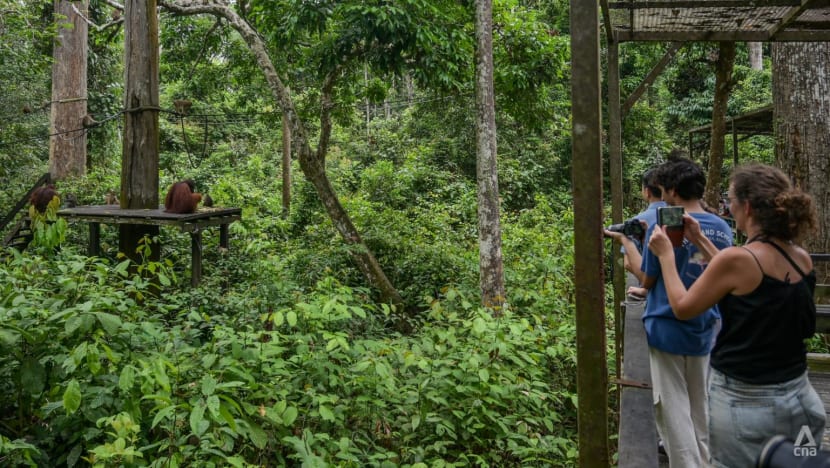
There is no guarantee, however, that visitors will get to see orangutans at feeding time – and for the centre’s staff, that’s a positive sign.
The feeding platform is a gateway between the centre and the forest, and the staff provide a limited and monotonous spread for the orangutans to encourage them to forage independently in the wild.
“The objective of this centre is for rehabilitated orangutans to be no longer dependent on us and to be free in the forest, where they can look for their own food,” said Mr Adrianus Tim Onong, a Sepilok officer.
During fruiting season, sometimes there are no orangutans at the feeding platform. That is not good for the visitors but it means that the programme is running well. It is good for the orangutans.”

The conservation and role of orangutans in Malaysia have come under the spotlight in recent months.
In May, plantation and commodities minister Johari Abdul Ghani said that the country should engage in “orangutan diplomacy” to counter bad press on palm oil and bolster relations with importers such as the European Union, India and China.
The European Union last year approved a ban on imports of commodities linked to deforestation, which could hurt the palm oil industry. Malaysia has criticised the law, calling it discriminatory.
Palm oil has been linked to the destruction of orangutan habitats, and Mr Johari said Malaysia – the world’s second-largest producer after Indonesia – cannot take a defensive approach.
Instead, it should show it is a sustainable palm oil producer committed to protecting forests and environmental sustainability, he said.
Inspired by China’s practice of sending pandas as diplomatic gifts to other countries, Mr Johari suggested giving orangutans to palm oil importers.
In 2023, the top importers of Malaysian palm oil were India (18.8 per cent), China (9.7 per cent), the European Union (7.1 per cent), Kenya (6.1 per cent) and Turkiye (5.8 per cent), according to the Malaysian Palm Oil Board.
The sector accounted for five per cent of the country’s gross domestic product in 2022.
But Mr Johari’s idea was quickly panned by conservationists as well as state officials in Sabah and Sarawak, the Malaysian states where wild orangutans are found.
Critics said it was more important to preserve the critically endangered animals’ natural habitats.
Between 1973 and 2010, Sabah lost about 40 per cent of its forest area while Sarawak lost 23 per cent, according to a 2014 study using satellite data. Conversion to plantations was a major driver of forest loss.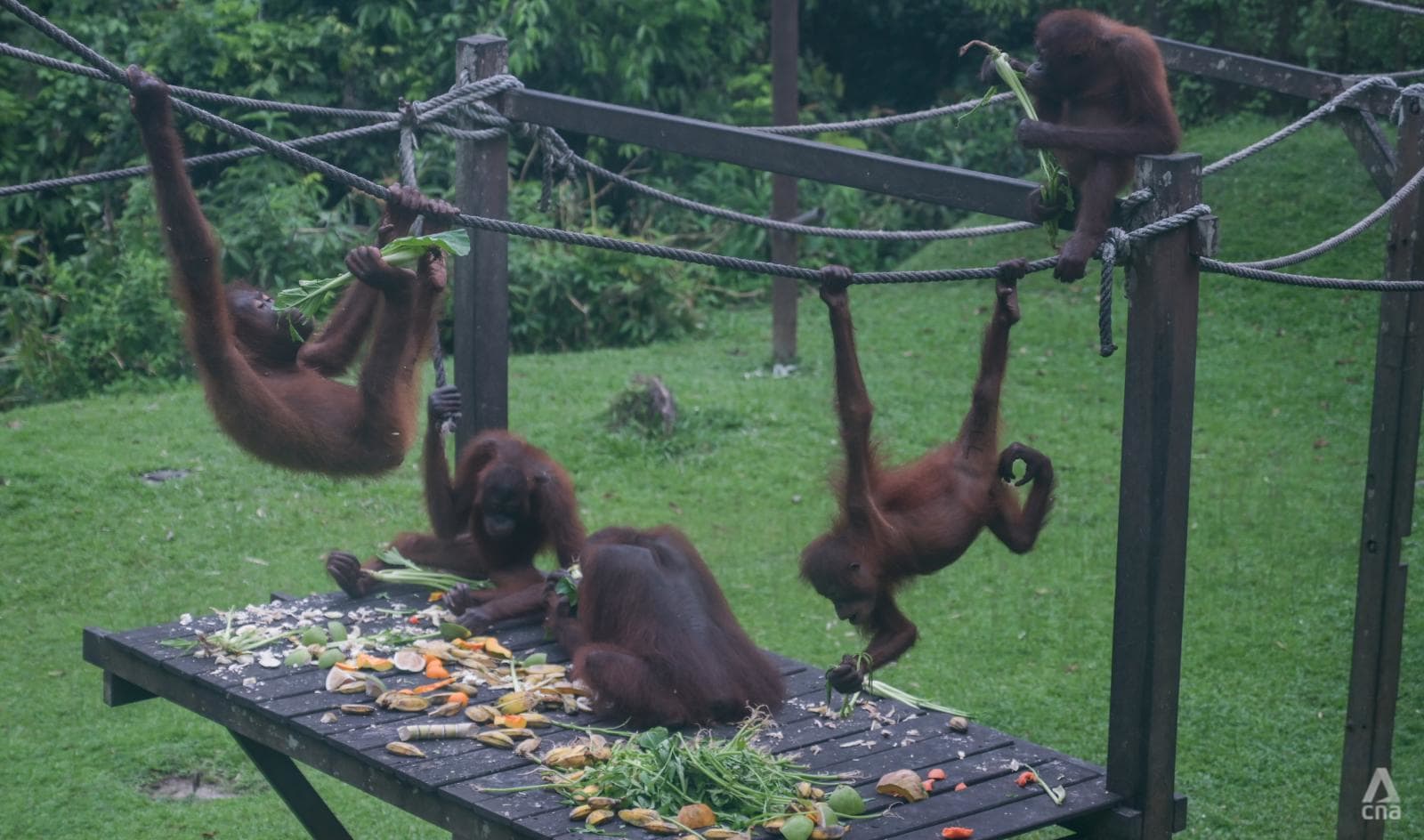
CARING FOR BABIES, THEN SETTING THEM FREE
On a trip last month to Sepilok, CNA learnt about the painstaking work of rehabilitating orangutans as well as some bright spots in conservation efforts.
The centre has not received any cases of orangutans being kept as pets in the last three years.
“Maybe it is also because of public awareness and people know that orangutans are protected. They don't keep them as pets and they let the orangutan live freely. There is less human and wildlife conflict,” said Dr Nabila Sarkawi, the centre’s resident vet.
The number of orangutan babies sent to the centre has decreased over the years, she said. “We have seen this trend since 2021. We are not sure why as no scientific research has been done to look at the factors.”
The centre received one baby orangutan last year, but Dr Nabila did not share figures for prior years.
Babies usually end up at the centre after their mothers are believed to have been injured, or have died.
“Baby orangutans live with their mothers up to the age of six or seven years. If they were found (alone) below that age, we have to take care of them and teach them how to survive,” said Dr Nabila.
Babies are looked after round the clock until they are old enough to learn basic skills, such as climbing and foraging, in an indoor nursery. This area of the centre is not accessible to the public.
Once they are bigger, they “graduate” to an outdoor nursery where they mingle with older orangutans and learn skills such as building nests.
Human contact here is minimised, although there is a viewing area for visitors behind a glass pane. The apes are also free to roam in the nearby forest.
They are released once they have adjusted to forest life and demonstrated satisfactory survival skills.
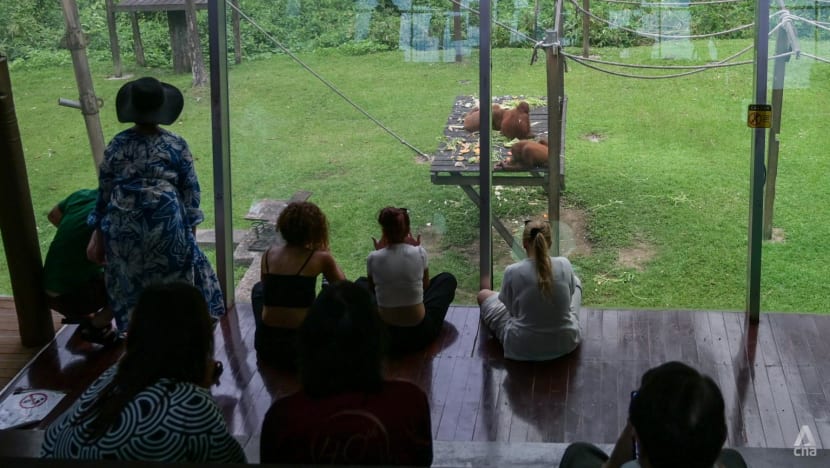
Dr Nabila estimates that about 60 per cent of orangutans that have been rehabilitated and released have adapted to life in the wild. The remainder are considered semi-wild and return to the centre – and its feeding platform – regularly.
“That’s the thing that people should understand. Once we have them as babies, they have humans as their ‘mothers’. It is hard to release them back because they keep coming back to us. They live in the forest, but only for a while. That is a challenge for rehabilitation,” she said.
Dr Nabila said the centre also cares for orangutans that are unable to live in the wild. Currently, there is one that is blind and about 10 others that have illnesses or are injured.
Besides Sepilok, the other centre in Malaysia that rehabilitates orangutans is Sarawak's Semenggoh wildlife centre.
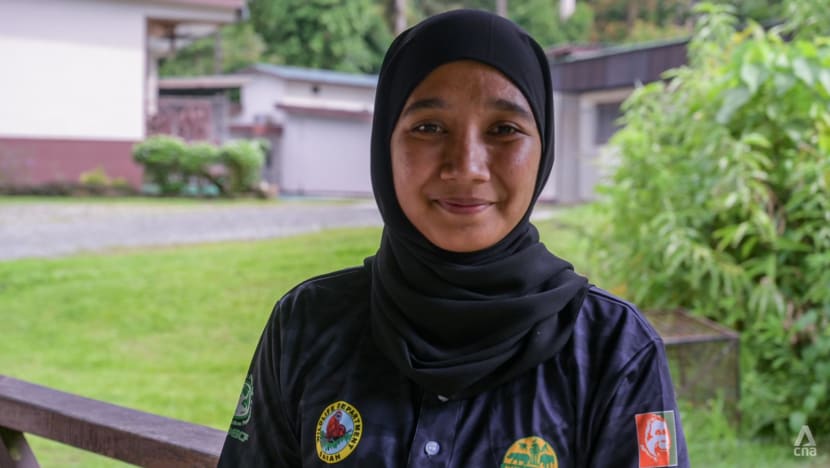
FORESTS NEEDED FOR ORANGUTANS’ LONG-TERM SURVIVAL
Mr Johari’s idea likely sparked debate because the orangutan is a well-known and iconic species, said Mr Marc Ancrenaz, scientific director of Hutan, a Sabah-focused conservation non-profit.
Like many of his peers, Mr Ancrenaz believes a better way of using the charismatic animal for diplomacy is for Malaysia to show the world it is ensuring the apes’ long-term survival by protecting their habitats.
“Orangutans are fully protected and are difficult to send overseas. There is also already an existing captive population overseas, unlike pandas,” he said.
According to various studies, about 1,000 to 1,100 orangutans live in zoos worldwide.
Other wildlife groups that have weighed in on Mr Johari’s suggestion include the World Wide Fund for Nature (WWF).
WWF-Malaysia said a more effective way for biodiversity and orangutan conservation is to improve forest management and to prioritise in-situ conservation, support sustainable palm oil production, and increase international funding for conservation efforts in developing countries.
While the population of Bornean orangutans has “stabilised in Sabah and Sarawak in recent decades”, there are still threats that need to be managed, it said.
“These threats come in the form of climate change, forest fires, forest fragmentation, conversion of forests for agriculture, mining and settlement,” the organisation said in a statement in May.
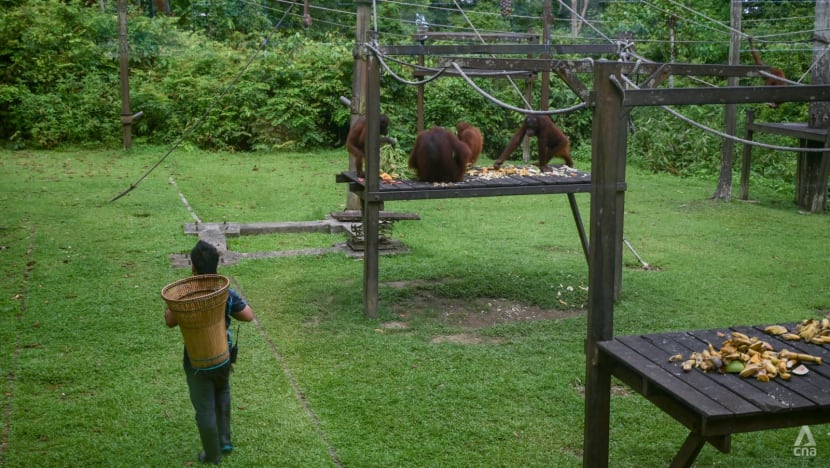
Dr Melvin Gumal, Sarawak Forestry Corporation’s (SFC) deputy chief executive (conservation) told CNA the number of orangutans in the state appears to have increased in the past few years, based on more sightings of the ape.
A mother with a pair of twins – a rarity – and another pregnant orangutan were seen at the state’s Batang Ai National Park recently, said Dr Melvin. The SFC is a statutory body of the Sarawak government that manages its totally protected areas and conserves its biodiversity.
He said Sarawak has a policy of protecting newer sites where orangutans are found.
“Orangutans are now seen in places where previously they had been avoiding, perhaps for fear of being hunted,” he said.
Surveys will be conducted this year to monitor the population of the species, added Dr Melvin.
As orangutans are culturally important to Sarawak, they should be protected in their native habitats, he said. The best way for countries that want to be part of the diplomacy programme is to inject conservation funds into field sites as well as research in the state, he added.
Fast facts about orangutans
There are three species of orangutans – the Bornean orangutan, Sumatran orangutan and Tapanuli orangutan. All are listed as critically endangered by the International Union for Conservation of Nature.
- There are an estimated 55,000 Bornean orangutans left. Malaysia’s Sabah state is home to an estimated 11,000 of them while Sarawak state has an estimated 3,000.
- The Sumatran orangutan is mostly found in northern Sumatra’s Leuser ecosystem. There are an estimated 13,846 of them left.
- The Tapanuli orangutan is found in the Batang Toru forests of North Sumatra and was confirmed as a separate species in 2017. There are about 800 of them left.
The World Wide Fund for Nature estimates that a century ago, there were more than 230,000 orangutans in the world.
Orangutans are “slow breeders”, said Mr Marc Ancrenaz, scientific director of Hutan, a Sabah-focused conservation non-profit.
They have babies every eight or nine years, and can only have a maximum of four or five babies in their lifetime, he added.
Female orangutans only mate once their babies have become independent.
NO LONGER A LIABILITY IN PLANTATIONS?
In recent years, the conservation of orangutans has shifted to their survival not only in forests, but also agricultural plantations.
It is one of the objectives of the Sabah Orangutan Action Plan 2020-2029, for instance. Oil palm plantations cover over 25 per cent of the state, the plan states.
While the plantations cannot sustain viable populations of orangutans and cannot be considered suitable for them, “it is urgent to acknowledge that agricultural landscapes are increasingly becoming part of the overall orangutan habitat”, the plan states.
“Therefore, patches and corridors of natural forests need to be retained within these landscapes, and opportunistic killing and hunting must be prevented at all cost.”
Orangutans and other wildlife such as elephants have ventured into agricultural landscapes because forests are getting more fragmented, said Mr Ancrenaz.
While orangutans could eat some fruit and cause some damage, they are not dangerous to humans, he said.
“If we look at it, the real damage is quite small compared to what the species can bring to Malaysia in terms of eco-tourism and research," he said, adding that research has found the orangutan to be very resilient.
We need to find ways to co-exist with the orangutan.”
Conservationists need to partner with the palm oil industry in light of the evolving situation, he said.
“For the longest time, everybody was blaming the industry for destroying the forest and species like the orangutan,” he said.
“There is some truth to these kinds of assertions, so for a very long time, it was very difficult for the industry and conservationists to engage. But then again, things are changing. There is less and less deforestation because of oil palm development in Malaysia.”
Co-existence is a relatively new concept, he said.
In the past, the view was that wildlife found in plantations needed to be relocated back to the forest. “This doesn’t really work,” he said.
More commodities companies are acknowledging the idea of co-existence, said Mr Ram Nathan, a former sustainability and conservation manager who used to work with a company that has timber and palm oil operations in Tawau district in Sabah.
Sightings of orangutans and their nests in forests within and around oil palm concessions have become more common over the years.
“The orangutans – both big and small – would appear when (the weather) wasn’t too hot. Once upon a time they were seen as a liability, but it has changed over the years,” said Mr Nathan, who retired in June last year after 34 years with the company.
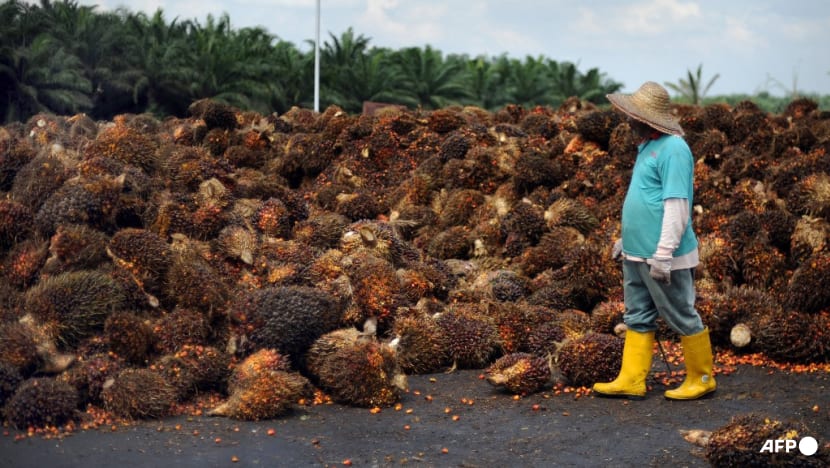
"ADOPT A WILD ORANGUTAN" IN THE WORKS?
The conservation community’s views appear to have been taken into account.
Three weeks after Mr Johari’s suggestion, the Malaysian Palm Oil Green Conservation Foundation (MPOGCF) spearheaded by the plantations ministry said it recommends an in-situ strategy for “orangutan diplomacy”, and is planning an initiative targeted at orangutans in agricultural zones.
It wants to rope in palm oil buyers to help conserve orangutans in high conservation value (HCV) areas of plantations in Sabah and Sarawak, and will hold discussions with stakeholders, said the foundation’s general manager Hairulazim Mahmud in a statement on May 30.
“For example, palm oil buyers will contribute RM100,000 (US$21,223) for each orangutan, effectively adopting them as ‘guardians’, thus directly supporting orangutan monitoring and conservation efforts within and around plantation areas,” he said.
“There are oil palm plantations with HCV areas covering 2,500 hectares and estimated wild orangutan populations of more than 50 individuals,” said Mr Hairulazim.
Such a proposal is likely to sit better with Sabahans like Ms Alice Eik, 47, for whom the orangutans are a source of pride.

“I am proud that Sabah is among the only places where there are wild orangutans,” said Ms Eik, a pastor who visited Sepilok last month with friends.
“Animals also have the right to live freely in the wild and the community has a responsibility to preserve the environment for every living being,” she said.



















